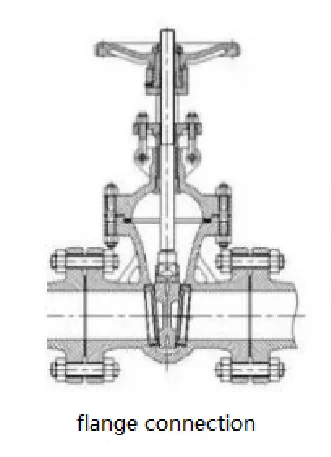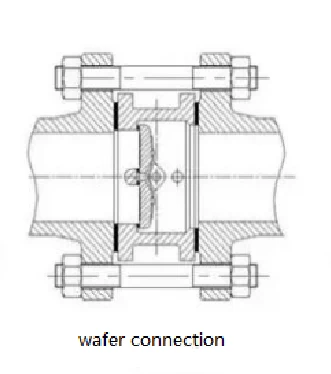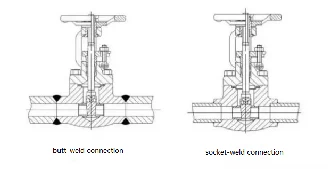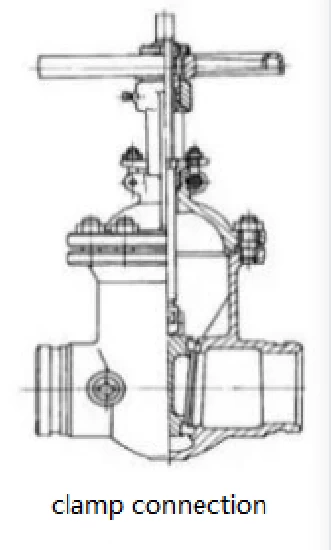Different connection methods between valves and pipelines
Different connection methods between valves and pipelines
The choice of connection method between valves and pipelines or equipment directly impacts the likelihood of issues such as leakage, dripping, or seepage in the pipeline valves. Common valve connection methods include flange connection, wafer connection, butt-weld connection, threaded connection, ferrule connection, clamp connection, and self-sealing connection, among others.
Flange connection
Flange connection involves flanges on both ends of the valve body corresponding to the flanges on the pipeline, secured with bolts to integrate the valve into the pipeline. It is the most commonly used connection method for valves. Flanges can have different surfaces, such as raised face (RF), flat face (FF), and male-female face (MF). Based on the shape of the sealing surface, flange connections can be categorized into the following types:
1. Smooth Type: Used for valves operating under low pressure; easy to machine.
2. Male-Female Type: Suitable for higher working pressures and can use medium-hard gaskets.
3. Tongue-and-Groove Type: Utilizes gaskets with high plastic deformation, widely used in corrosive media, providing excellent sealing performance.
4. T-shaped Groove Type: Employs oval-shaped metal gaskets and is used for valves operating at pressures ≥ 64 kg/cm² or for high-temperature valves.
5. Lens Type: The gasket is lens-shaped and made of metal, suitable for high-pressure valves operating at pressures ≥ 100 kg/cm² or high-temperature valves.
6. O-ring Type: A newer flange connection method developed alongside the advent of rubber O-rings. It offers more reliable sealing than standard flat gaskets.

Wafer Connection
In a wafer connection, the valve is installed between two flanges. The valve body typically features alignment holes to facilitate positioning during installation. Bolts are used to clamp the valve and the two ends of the pipeline together, forming a secure connection. Cowinns is one of high pressure dual plate check valve manufacturer,the dual plate check valves are designed with wafer type normally.

Welded Connection
1. Butt-Weld Connection: The ends of the valve body are machined with bevels according to the requirements for butt-weld connections, corresponding to the bevels of the pipeline. The valve is fixed to the pipeline through welding.
2. Socket-Weld Connection: The ends of the valve body are machined for socket-weld connections and are connected to the pipeline using socket welding.

Threaded Connection
Threaded connection is a simple and convenient method, commonly used for small valves. The valve body is machined according to various threading standards, with internal and external threads to match the threads on the pipeline. There are two types of threaded connections:
1. Direct Sealing: The internal and external threads directly serve as the sealing mechanism. To ensure a leak-free connection, materials like lead oil, hemp, or polytetrafluoroethylene (PTFE) tape are often used for filling. Among these, PTFE tape is increasingly popular due to its excellent corrosion resistance, superior sealing performance, ease of use, and convenient storage. PTFE tape can also be completely removed during disassembly as it is a non-adhesive thin film, making it significantly better than lead oil or hemp.
2. Indirect Sealing: The tightening force of the threads compresses a gasket between two flat surfaces, which then provides the seal.
Common Thread Types:
1. Metric General Thread
2. Imperial General Thread
3. Sealing Pipe Thread
4. Non-Sealing Pipe Thread
5. American Standard Pipe Thread
Overview of Standards:
1. ISO 228/1, DIN 259 (International Standard): Parallel internal and external threads, designated as G or PF (BSP.F).
2. ISO 7/1, DIN 2999, BS 21 (German Standard): Tapered external threads and parallel internal threads, designated as BSP.P or RP/PS.
3. ISO 7/1, BS 21 (British Standard): Tapered internal and external threads, designated as PT, BSP.Tr, or Rc.
4. ANSI B21 (American Standard): Tapered internal and external threads, designated as NPT. The thread angle for BSP.F, BSP.P, and BSP.Tr is 55°, while for NPT, it is 60°.
American Standard Pipe Threads:
American standard pipe threads include five types:
- NPT: Tapered pipe threads for general use.
- NPSC: Straight internal pipe threads for pipe couplings.
- NPTR: Tapered pipe threads for rod connections.
- NPSM: Straight pipe threads for mechanical connections (free fit).
- NPSL: Straight pipe threads for mechanical connections with locknuts (loose fit).
These are part of the non-sealing pipe threads category.
- N: American National Standard
- P: Pipe
- T: Tapered
Ferrule Connection
Ferrule connection has been developed in recent years in China. Its connection and sealing principle is based on the ferrule being compressed when the nut is tightened. This compression causes the ferrule's edge to bite into the outer wall of the pipe while the outer conical surface of the ferrule tightly seals against the inner conical surface of the fitting under pressure. This effectively prevents leakage, making it a common choice for instrument valves.
Advantages of Ferrule Connection:
1. Compact and Lightweight: Small size, light weight, and simple structure, making it easy to assemble and disassemble.
2. Strong Connection: Suitable for a wide range of applications, capable of withstanding high pressure (up to 1000 kg/cm²), high temperature (up to 650°C), and shock or vibration.
3. Material Flexibility: Can be made from various materials, making it ideal for corrosion-resistant applications.
4. Low Precision Requirements: Does not demand high machining precision.
5. Ease of Installation: Particularly convenient for installations at high altitudes.
Currently, the ferrule connection method is being used in some small-diameter valve products in China.
Clamp Connection
Clamp connection is a quick connection method that requires only two bolts. It is suitable for low-pressure valves that need frequent disassembly, such as sanitary valves.

Internal Self-Sealing Connection
The previously mentioned connection methods rely on external force to counteract the pressure of the medium for sealing. In contrast, the internal self-sealing connection utilizes the pressure of the medium itself to achieve sealing.
In this connection method, the sealing ring is positioned within an internal conical surface at a specific angle relative to the medium-facing side. The pressure from the medium transfers to the internal cone and then to the sealing ring. On the angled conical surface, this creates two force components: one parallel to the valve body's centerline, directed outward, and another pressing against the inner wall of the valve body. This latter force is the self-sealing force. The higher the medium pressure, the greater the self-sealing force, making this connection method suitable for high-pressure valves.
Compared to flange connections, self-sealing connections save significant material and labor. However, they still require a certain level of pre-tightening to ensure reliability when the internal pressure of the valve is low. Valves designed with self-sealing principles are generally used in high-pressure applications.
Additional Notes on Valve Connections:
- For some valves, especially small ones that do not require disassembly, welding directly to the pipeline is an option.
- Certain non-metallic valves use socket connections.
Valve users should choose connection types based on specific operational needs and requirements:
1. All connection methods must comply with relevant standards. It is crucial to understand the user’s required standards clearly to avoid incompatibility during installation.
2. Typically, large-diameter pipelines and valves use flange connections, while small-diameter pipelines and valves often use threaded connections.
 +86 512 68781993
+86 512 68781993 


















